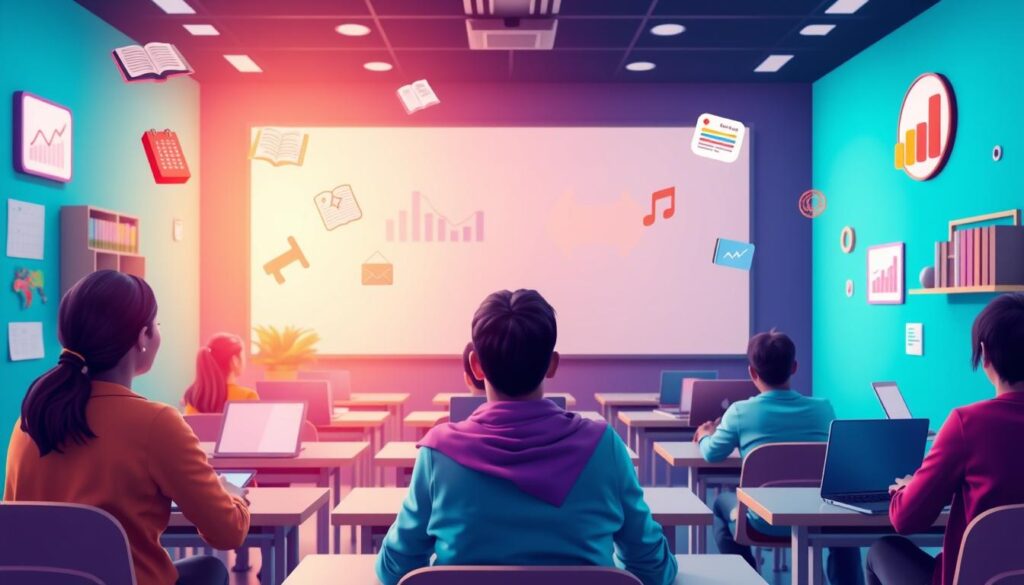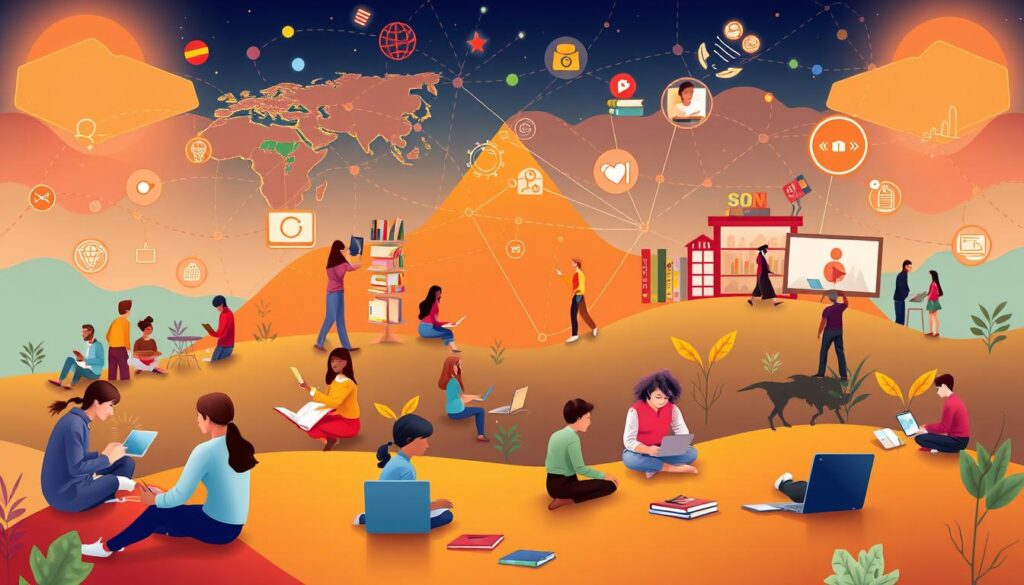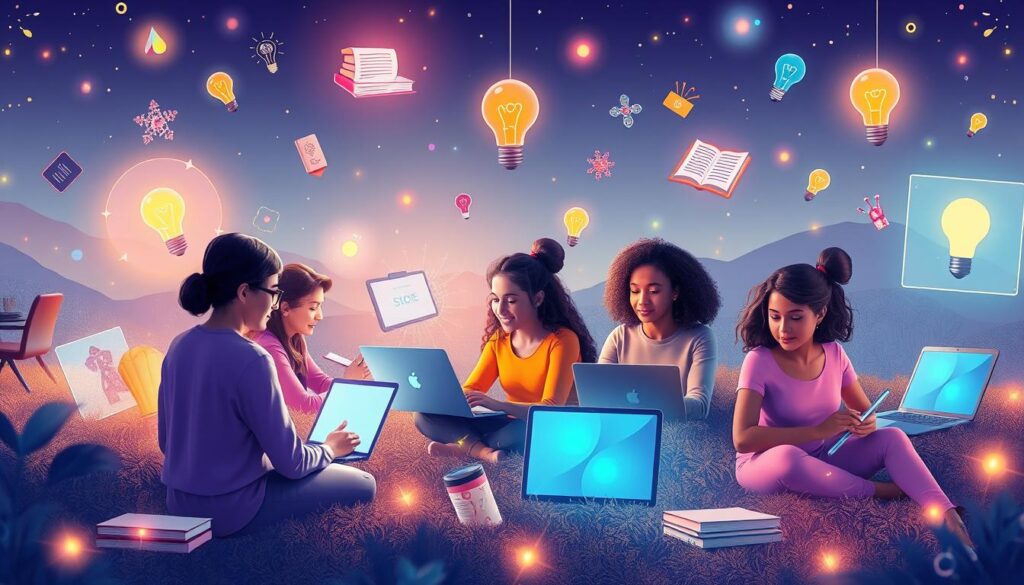In today’s fast-paced digital world, online learning is key. It changes how we learn, making knowledge more accessible. With new tech, e-learning is more popular than ever.
It lets learners reach educational resources from anywhere. The Online Learning Consortium found over 6 million U.S. students take online courses each year. This shows a big demand for digital education and learning systems.
This shift to online learning shows a change in how we want to learn. It’s about finding flexible, accessible, and varied learning options.

Key Takeaways
- Online learning allows access to educational resources from anywhere.
- Over 6 million U.S. students take at least one online course each year.
- E-learning is redefining education by breaking geographical barriers.
- Learning management systems facilitate organized digital education.
- The popularity of online learning reflects changing educational demands.
The Evolution of Online Learning
Online learning has come a long way, changing how we get educated. It started with distance education and grew thanks to new tech. This journey shows us how e-learning and educational tech have changed.
History of Distance Education
Distance education began with mail-based courses in the 19th century. It was the first step towards learning outside of school. The 1990s saw a big change with the Internet. Now, online courses are common, helping more people learn.
Growth of E-learning Platforms
Platforms like Coursera, Udemy, and Khan Academy have changed education. They make learning accessible to everyone, no matter where they are or how much money they have. This has made learning more flexible and fun for all.
Impact of Technology on Educational Trends
New tech has changed education a lot. Mobile learning lets students learn anywhere, anytime. Adaptive learning makes learning personal and fun. These changes make learning better and more enjoyable.
| Era | Key Developments | Impact on Learning |
|---|---|---|
| 19th Century | Correspondence Courses | Accessibility for remote learners |
| 1990s | Internet Introduction | Transition to online education |
| 2000s-Present | Emergence of E-learning Platforms | Wide range of online courses |
| Current | Advancements in Educational Technology | Enhanced engagement and personalization |
Benefits of Online Learning
Online learning offers many benefits, making it a great choice for students. It allows for a flexible schedule, fitting studies into busy lives. This approach helps those with jobs, family, or other commitments.
Flexibility and Accessibility
Online learning is known for its flexibility. Students can study at their own pace, fitting it into their lives. This is key for those with many responsibilities.
With online courses, there’s no need to follow a strict schedule. Students can learn when it’s best for them. This makes learning accessible to everyone, no matter where they are.
Cost-effectiveness Compared to Traditional Education
Online learning is often cheaper than traditional schools. Students save on travel, housing, and other costs. Studies show online degrees can be much more affordable.
The U.S. Department of Education found online students pay less than those in class. This helps learners save money while still getting an education.

Online Learning: A Tool for Lifelong Learning
Online learning is key for lifelong learning, letting people keep learning anytime. It offers many online tutorials and blended learning programs. This way, learners can get new skills and improve what they already know easily.
It’s great for professionals who must keep up with job market changes. They can pick training that fits their career goals. Online learning helps everyone, at any career stage, to succeed in today’s world.
Platforms like LinkedIn Learning and the Association for Talent Development stress the need for constant learning. They have many online tutorials. These let users learn at their own speed, fitting it into their work and life.

Blended learning is also good for lifelong learning. It mixes old-school classroom learning with new online methods. This way, learners get the best of both worlds. It helps them smoothly pick up new skills, supporting their career growth.
| Learning Method | Description | Benefits |
|---|---|---|
| Online Tutorials | Self-paced video lessons and interactive content | Flexible timing and access to diverse topics |
| Blended Learning | Combination of in-person classes and online resources | Enhanced engagement and adaptability for various learning styles |
| Continuous Education | Ongoing training and skill development | Staying competitive in the job market |
Online learning helps us grow personally and professionally. As we need to keep learning more, using these tools is crucial. It helps us succeed and stay adaptable in our careers.
Virtual Classrooms and Their Role in Modern Education
Virtual classrooms have changed education, offering new ways to learn. They use tools to make learning fun and engaging. This is different from traditional classrooms.
Engaging Features of Virtual Classrooms
Virtual classrooms stand out because they have interactive features. These features include:
- Video conferencing: Allows students and teachers to talk in real time, creating a lively learning space.
- Real-time feedback: Teachers can give feedback right away, helping students learn faster.
- Gamification: Adds fun elements to learning, making it more enjoyable and effective.
These features help keep students interested and motivated in their studies.
Community and Collaboration in E-learning Environments
Virtual classrooms also help build a strong community. Students can work together in many ways:
- Discussion forums: Give students places to share thoughts and ask questions, helping them learn from each other.
- Group projects: Encourage teamwork, helping students develop important skills.
- Networking opportunities: Help students and teachers connect, making learning more valuable.
Studies show that building a community is key in online learning. It creates deeper connections and a richer learning experience.
The Future of Online Learning in the Digital World
Online learning is set for a big change, thanks to new trends and tech advancements. The future of education looks to be more personalized, thanks to artificial intelligence. AI can tailor learning to each student, making sure they stay engaged and move at their own pace.
Micro-credentials are also changing how we learn skills quickly. They’re great for adults and professionals looking to improve their skills. The World Economic Forum says micro-credentials might soon be as valued as traditional degrees.
Augmented and virtual reality are making online learning more interactive and fun. These technologies help learners understand and remember information better. As we move forward, education will become more inclusive and transformative for everyone.
Conclusion
Online learning has emerged as a transformative force in modern education, reshaping how individuals access and engage with knowledge in the digital age. Offering unparalleled flexibility, accessibility, and cost-effectiveness, it empowers learners to study at their own pace, anytime, anywhere, breaking traditional barriers to education.
E-learning platforms and virtual classrooms have revolutionized lifelong learning, equipping individuals with critical skills for an ever-changing job market. Technologies like AI, micro-credentials, and virtual reality are driving innovation, delivering more personalized, engaging, and inclusive educational experiences.
Beyond professional development, online learning fosters global collaboration, allowing students and professionals to connect across borders, share ideas, and access diverse perspectives. It democratizes education, ensuring that quality learning opportunities reach underserved communities.
As the digital landscape continues to evolve, online education remains a cornerstone of global progress, bridging gaps in accessibility and paving the way for a more knowledgeable, inclusive, and connected society. By embracing these advancements, the future of learning promises to be even more dynamic, interactive, and impactful for individuals worldwide.
FAQ – online learning
What is it?
This type of learning is a form of education that takes place over the internet, allowing students to access courses, materials and resources from anywhere, without having to attend face-to-face classes.
What are the benefits?
The main benefits include flexibility, accessibility, lower costs, personalized pacing, and the ability to access a wide range of educational resources anytime and anywhere.
Is this type of learning effective?
Yes, studies show that this type of learning can be as effective as face-to-face education, especially when well-structured platforms are used, combined with interactive and engaging teaching methods.
Is online learning cheaper than traditional education?
Often, yes. Online learning eliminates costs like transportation, housing, and often textbooks, and typically offers more affordable options compared to traditional institutions.
What technologies are used?
A variety of technologies are used, such as learning management systems (LMS), video conferencing, discussion forums, gamification features, artificial intelligence, and virtual and augmented reality tools.
Can you earn degrees or certifications through e-learning??
Yes, many universities and institutions offer online courses, degrees, and certifications that are fully accredited and hold the same value as those earned through in-person programs.
What skills are needed to be successful in this type of learning?
Skills such as self-discipline, time management, basic computer skills and the ability to work independently are essential for success.
How can you help with professional development?
Yes, because it offers opportunities to acquire new skills, improve existing ones and stay up to date with changes in the job market, facilitating career advancement.
What are virtual classrooms?
Virtual classrooms are digital spaces where students and teachers interact in real-time through video conferencing, chats, and other online tools. They simulate a traditional classroom environment remotely.
What is the future of online learning?
The future of online learning is expected to be more interactive and personalized, with increased use of technologies like artificial intelligence, micro-credentials, and augmented/virtual reality, making education more accessible and dynamic.
More about online learning.



